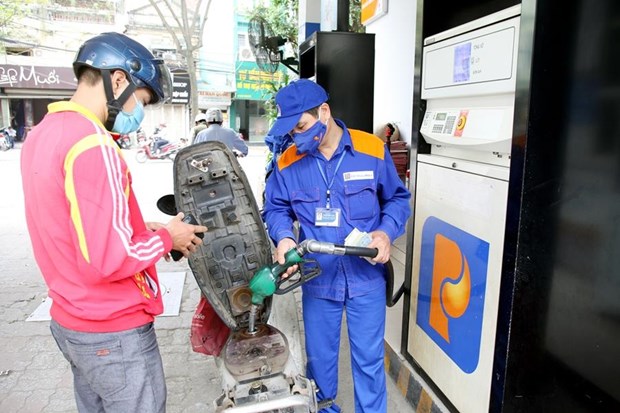 Economy
Economy

The surge of commodities prices since the beginning of the year has different effects on Vietnamese companies.

|
| A customer buys petrol at a Petrolimex station. Photo vietnamplus.vn |
HÀ NỘI — The surge of commodities prices since the beginning of the year has had different effects on Vietnamese companies.
According to Việt Nam Food Association (VFA), Việt Nam's 5% broken rice was quoted at US$518 - 522 per ton in early March, continuing its rally.
In the first two months of 2021, the average rice export price was US$551.7 per ton, up 3.4 per cent compared to December 2020 and up 15.4 per cent over January 2020.
Trung An Hi - Tech Farming Joint Stock Company (TAR) told tinnhanhchungkhoan.vn that the company exported rice with higher prices in early 2021. Of which, 450 tonnes of Jasmine 85 rice were sold at US$680 per ton to Singapore, while 1,150 tonnes of fragrant Jasmine rice were exported to Malaysian customers at US$750 per ton.
After posting a gain of 47.7 per cent in revenue and 46.5 per cent in profit after tax in 2020, TAR is expected to maintain its growth in 2021 on predicted higher rice prices.
Thành Thành Công - Biên Hòa JSC (SBT) and Sơn La Sugar JSC (SLS) announced gains in revenue and profit in the first half of financial year of 2020 - 2021 as international sugar prices recovered, pushing up the domestic sugar price.
Raw-sugar for May delivery, which is traded on Intercontinental Exchange (ICE), was traded at 15.77 US cents/lb on Monday, up 38.3 per cent over the same period last year. The bullish trend of sugar prices has started since early May 2020. The price even broke over 18 US cents/lb at the end of February.
The application of an anti-dumping and anti-subsidy duty on raw-sugar from Thailand in early February also supports companies in the industry.
In the rubber market, companies that specialise in exporting natural latex like Phước Hòa Rubber JSC (PHR), Đồng Phú Rubber JSC (DPR) and Tây Ninh Rubber JSC (TNR) are expected to benefit from the rise of rubber prices.
Rubber futures which are traded on Tokyo Commodity Exchange (TOCOM) have climbed since the beginning of 2021.
In Monday's trade, rubber price was 263 yen/kg, up 14.84 per cent compared to the start of the year and up nearly 94.6 per cent over the same period of last year. It even crossed 330 yen/kg at the end of January.
Data from to General Department of Việt Nam Customs showed that in January, the country's average rubber export was US$1,611 /ton, up 1 per cent against that of December 2020.
Concerns of declining profit margins
Meanwhile, rubber tyre manufacturers like Đà Nẵng Rubber JSC (DRC), The Southern Rubber Industry JSC (CSM) and Sao Vàng Rubber JSC (SRC) are worried that higher rubber prices will cause higher raw materials costs, leading to a drop in profit margin.
Natural rubber, synthetic rubber (made from oils) and coal are the main materials in producing tyres and account for 60 per cent of raw materials cost, of which natural rubber occupies up to 35 per cent.
Crude oil is another commodity recording outstanding performance this year.
Brent crude, which is traded on ICE, was $64.31 a barrel on Monday, up 25.8 per cent in 2021 and up 135.57 per cent against the same period last year. The gain started since early November 2020. The benchmark even reached $70 a barrel in early March after Saudi Arabia's oil production facilities were attacked.
Higher oil prices lead to higher gas and distillate product prices.
In the local market, after the price adjustment from the Ministry of Finance and Ministry of Industry and Trade on March 12, retail prices of some fuels hit a one-year high.
Carriers like Vietnam Airlines JSC (HVN) or Vietjet Aviation JSC (VJC) will suffer more as fuel cost accounts for 30 - 40 per cent of their operating expenses, while the number of flights fell due to the outbreak of COVID-19.
The rise of fuel prices will also have a negative impact on thermal power and fertiliser industries as fuels are one of the main materials. — VNS




